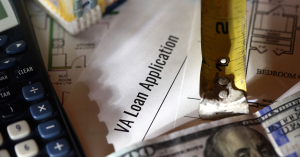If you’re a veteran or active-duty service member, you know all about rising to the occasion and facing challenges head-on. And when it comes to the challenge of homeownership, the VA loan might just be your secret weapon.
But a question I often hear is, do VA loans have PMI – that pesky Private Mortgage Insurance that so often adds an extra pinch to your pocketbook? Drumroll, please!
Let’s pull back that curtain and reveal the truth behind VA loans and PMI. Trust me, when it comes to homeownership, this knowledge isn’t just power- it’s pure gold!
Unraveling the Basics of VA Loans
Alright, let’s dive right in. What’s a VA loan? Sounds fancy, doesn’t it? In reality, it’s as straightforward as seeing the sun come up in the morning.
What Are VA Loans?
VA loan, in simpler terms, is short for Veterans Affairs loans. These aren’t just any regular loans. These are specifically designed home loans with our fearless service members. Whether you’ve served as an active-duty military member or are a veteran now enjoying some well-deserved quieter life, or perhaps a surviving spouse – this benefit is for you.
The Benefits
Feeling intrigued? You should be. Here’s where things get exciting, the benefits of VA loan include:
- Zero Down Payment: That’s right, goose egg, nada, I’m talking a big ol’ zero for a downpayment. For most other loans, this would be as likely as finding a unicorn riding the rainbow. But with Veteran Affairs loans, it’s as real as it gets.
- Competitive Interest Rates: Because this loan is backed by the government, lenders feel more secure. That warm, fuzzy feeling often translates into lower interest rates. So, it’s like catching a break on a big hill climb; easier and more enjoyable.
- VA No No Loan: Beyond just offering zero down payment, the VA even steps up the game with the VA No No loan. This type of loan allows the veteran to purchase a home with no down payment and no out-of-pocket closing costs. The seller pays all closing costs, making it even more financially feasible for veterans.
The Drawbacks
Now, let’s not just sing praises, every coin has two sides:
- Limited to Primary Residences: According to VA loan occupancy requirements, the property you purchase using a VA loan should be your primary residence.
- Funding Fee: There’s always a catch, right? This loan come with a funding fee. But don’t worry, we’ll chat more about this later.
Eligibility for VA Loans
So you’re probably thinking, “Sign me up!” But slow down, eager beaver, to be eligible for a VA loan, you need to meet certain criteria:
- Service Requirements: There are set military service requirements. That could mean serving a specific length of active-duty service or meeting guidelines for service in the Reserves or National Guard.
- Certificate of Eligibility: It’s not enough to meet the service requirements; you also need a Certificate of Eligibility (COE). This is basically your golden ticket saying, “Yes, you’ve earned this benefit!”
- Financial Requirements: Yes, the government wants to ensure you can afford the loan. So, lenders will review your income, debts, and credit history before granting approval. But don’t worry, understanding those elements is all part of the journey, your journey to owning a home, VA style!
Do VA Loans Have PMI (Private Mortgage Insurance)?
Get ready, because we’re diving deep into the maze of PMI:
Understanding PMI
First and foremost, it’s important to understand the true nature of Private Mortgage Insurance (PMI). PMI functions as a form of insurance for the lender, providing them with protection in the event that you are unable to fulfill your loan obligations.
This insurance coverage becomes mandatory when obtaining traditional or FHA loans, particularly if your initial down payment amounts to less than 3.5%. of the property’s value. In such cases, PMI serves as a necessary safeguard for the lender.
The Link Between PMI and VA Loans
Now, where does the PMI fit in this puzzle? Here’s the major spoiler: For most VA loans, there’s no PMI, irrespective of your down payment. It’s an added privilege of the VA loans, stepping up your homeownership game a level.
The Reasoning Behind No PMI
How does the VA loan pull off this no PMI stunt? The government backs VA loans. So, if you default, the government steps in to cover the lender. This assurance allows the lender to forget about PMI, resulting in monthly savings for you.
PMI Exceptions
Is there a scenario where PMI enters the VA spotlight? In usual circumstances, PMI wouldn’t feature with a VA loan. However, in rare scenarios, like refinancing a VA loan to a conventional loan, PMI might spring up.
What Is The VA Home Loan Funding Fee?
Buckle up as we’re headed for a deep dive into an essential pitstop in our journey – the VA home loan funding fee. But fear not, we’ll take this journey together, one mile marker at a time.
Breaking Down the VA Funding Fee
Before you break into a sweating fit of worry, let’s understand what this funding fee is all about:
- Think of the VA Funding Fee as a way for you to pay it forward for other veterans. It’s a fee charged to every VA home loan (subject to some exemptions) that goes into keeping the VA home loan program running for future veterans.
- It’s a one time payment, not a recurring charge. Consider it the price of admission to the awesomeness of VA loans.
The Importance of the VA Funding Fee
The funding fee may seem like unnecessary baggage, but trust me, it has its perks:
- It Keeps the Program Going: The collected funding fee helps offset the cost for taxpayers and ensures the VA loan program can continue to benefit future service members.
- It Allows No Down Payment and No PMI: This small fee bolsters the benefits of VA loans, like zero down payment and the absence of Private Mortgage Insurance.
The VA Funding Fee in Practice
A widely asked question is, how does the fee work within the VA loan framework?
Well, the funding fee is due at closing. It’s typically rolled into the total of the loan, so it doesn’t require an upfront, out-of-pocket payment.
How Much Am I Paying?
The million-dollar question is, what’s the actual cost?
The exact amount you pay as your funding fee varies depending on several factors like the type of service, whether it’s your first VA loan, your loan’s details, and whether you choose to make a down payment.
Now have no fear, armed with insights about the VA home loan funding fee, you’re well-equipped to navigate the terrain of VA loans like a seasoned explorer!
Do You Have to Pay PMI on A VA Loan Program?

You don’t need to worry about PMI knocking on your door unless in special, and quite rare cases.
Circumstances Where PMI Might Appear
Like in any mystery, there are always twists. While rare, there could be particular situations where PMI might wander onto the VA loan stage:
- Refinancing is one such scenario. If you’re refinancing from a VA loan to a conventional loan, PMI might sneak in as an uninvited guest.
- Some lenders might insist on PMI if they perceive the loan as high risk. This situation, however, is more an exception than a rule.
What You Should Remember
Here’s your ready-to-go bullet list to remember the PMI-VA loan relationship:
- As mentioned earlier, VA mortgage loans generally don’t require PMI, even with no or low down payment.
- Government backing replaces the need for PMI by providing lenders security.
- Some scenarios, especially involving refinancing to a conventional loan, might bring PMI into the picture.
VA Funding Fee vs. PMI
It’s time for the ultimate showdown: the VA Funding Fee versus PMI. Are they dueling twins or just distant cousins? Let’s pull back the curtain on this face-off.
The Shared Goal
First off, let’s establish common ground. Both the VA funding fee and PMI exist to safeguard the lender’s interests. They’re like the guard dogs that keep the lender’s risk at bay.
The One-Time Guest
Let’s talk about our first contestant – the VA Funding Fee:
- Unlike its counterpart PMI, the VA funding fee only shows up once. It’s like a one time cover charge for the exclusive club that VA loans are.
- The fee is usually bundled into the loan amount. That means you don’t have to scramble to come up with cash out-of-pocket at the time of closing.
The Monthly Visitor
Now, onto the other side – PMI:
- PMI is like that monthly subscription service; it keeps on billing, usually until you’ve hit 20% equity in the home.
- It needs to be paid separately every month, along with your mortgage payment.
The Key Differences At a Glance
So how do these two big players in the mortgage world really square up?
- Frequency: One of the main differences lies in the payment frequency. The VA funding fee is a one time charge, whereas PMI visits your bank account monthly.
- Payment Handling: Another crucial difference is how you handle their payments. The VA funding fee can be rolled into your loan amount, easing your initial financial commitment. In contrast, PMI adds to your monthly expenditure.
Who Wins?
Drawing from my depth of experience in handling VA mortgage loans, I can confirm that there’s no winner or loser in this match. Both the VA funding fee and PMI serve the same ultimate purpose – to protect the lender. However, when it comes to the borrower’s experience, the VA funding fee generally feels less burdensome with its one-time charge and inclusion in the loan balance.
How Much Is The VA Funding Fee?

How much will this party cost, you wonder? It’s the million-dollar question, or should I say the a-few-thousand-dollar question? The exact VA funding fee varies, largely depending on factors like your military category, whether you’ve used the benefit before, or how much down payment you’re making.
Let’s take a look at how your particular situation might shape your funding fee:
| Type of Veteran | Down Payment | First-Time Use Funding Fee | Subsequent Use Funding Fee |
|---|---|---|---|
| Regular Military | Less than 5% | 2.15% | 3.3% |
| Regular Military | 5% or more | 1.5% | 1.5% |
| Regular Military | 10% or more | 1.25% | 1.25% |
| Reserves/National Guard | Less than 5% | 2.4% | 3.3% |
| Reserves/National Guard | 5% or more | 1.75% | 1.75% |
| Reserves/National Guard | 10% or more | 1.5% | 1.5% |
When Is The VA Funding Fee Paid?
The timing of the VA funding fee can seem a bit daunting at first. But worry not, let’s unravel the specifics of this fee and its payment schedule.
Payment Timing
Let’s first address the critical question of ‘when’ in relation to the VA funding fee. The fee isn’t due immediately when you choose a VA loan; it’s payable at closing.
Incorporating the Fee into the Loan
Here’s how the VA funding fee slots into your overall loan scenario. More often than not, this fee forms part of your total loan balance, allowing gradual payments over time rather than upfront.
Possible Exceptions
Just as in any rule book, there are exceptions that could change the beat:
- Some lenders might offer you the choice to pay the fee upfront instead of including it in your loan balance.
- In instances of refinancing, the timing of this fee may vary and is typically due at closing.
So, don’t fret over the VA funding fee. It takes a comfortable seat in the closing chapter of your VA home loan process, ensuring no unexpected financial jump scares.
VA Funding Fee Exemptions
In all my years working with VA loans, it’s important to know that there are certain cases where borrowers may be exempt from the VA funding fee. These exemptions are designed to offer further financial relief to those who qualify.
Who’s Exempt?
Let’s put on our detective glasses and identify who these fortunate individuals might be:
- Veterans receiving VA compensation for a service-connected disability. This is the VA’s way of appreciating the sacrifices these veterans have made.
- Similarly, a veteran who would be entitled to receive compensation for a service-connected disability if they didn’t receive retirement or active duty pay gets an exemption ticket too.
Unraveling the Exemption Enigma
To further lift the fog around this:
- A service member who evidences that they’ve been awarded the Purple Heart, on or before the date of loan closing, seizes an exemption too.
- Also, the unspoken heroes, the surviving spouses of veterans who died in service or from a service-connected disability, are exempted from this funding fee.
Obtaining and Validating the Exemption
So, if someone’s found a golden exemption ticket, what’s next?
- The exemption needs to be validated by issuing a Certificate of Eligibility through the VA. It’s similar to getting that shiny ticket stamped for a grand event!
- Borrowers need to update their lender about their exemption status for the funding fee waiver to be applied to their loan.
Fee Refund
What if you already paid the funding fee but found out later that you were eligible for a funding fee exemption? Well, don’t you worry, the VA has got your back!
- There can be instances where a veteran may qualify for a refund of the VA funding fee. The commonly seen scenario involves a veteran receiving approval for their disability claim after closing, making them exempt retroactively.
- It’s critical for you to communicate with the VA and your lender, providing the necessary documentation to ensure your exempt status. This step paves the way to adjust your loan account and process any refund of the funding fee you’re eligible for.
So, the possibility of this funding fee refund adds another layer of security and advantage for our brave service members in their journey towards homeownership with VA loans.
The Path to Acquiring a VA Loan

Ready to ride this financial rollercoaster? Great! Acquiring a VA loan is easier than finding your favorite show on Netflix, and I’ll guide you through every step of it.
From document preparation to the moment you become a homeowner, let’s break it down.
Document Preparation
First things first, prepare your paperwork. This step includes collecting:
- Common loan documents like proof of income, details about your assets and debts, and your Social Security number.
- Military-specific documents, such as your current or former Statement of Service or Discharge paper.
Get Your COE
The next crucial step is obtaining your Certificate of Eligibility (COE):
- Your COE is your passport to the VA loan benefit world.
- You can apply for your COE through the VA’s eBenefits portal, by mail, or through your lender.
Apply for VA Loan
With your COE in hand, it’s time to apply for the loan:
- Choose a lender familiar with this type of loan and plunge into the application process.
- The lender will review your financial situation and decide on loan approval accordingly.
Loan Closing
Once your loan is approved, it’s time for closure:
- You and the lender will agree on loan terms, you’ll pay any expenses due at closing, and sign the agreement.
- Remember, most fees, like the VA funding fee, are often bundled into your loan balance.
Homeownership Celebrations
And voila! You’ve done it. Celebrate this momentous accomplishment, you’ve navigated the loan journey and are now officially a homeowner!
Opening the Door to Your Dream Home

The journey of understanding and securing a Veteran Affairs loan may seem daunting, but trust me, it’s a trip worth taking. This route unfolds remarkable benefits for you, our nation’s heroes, making your dream of homeownership achievable and affordable.
So grab hold of the key. With the insights you’ve gained, navigate this path with renewed confidence. Your new home awaits, just a few straightforward steps away. The journey may have its twists and turns, but at the end of it, stands your new home, your personal paradise.
Frequently Asked Questions on Do VA Loans have PMI
Do VA and FHA loans require PMI?
VA mortgage loans do not require Private Mortgage Insurance (PMI), irrespective of how much down payment you make. This is one of the significant benefits they offer compared to traditional loan options. However, FHA loans do require PMI, which is called Mortgage Insurance Premium (MIP) in their case. This required insurance secures the loan in case of default on the part of the borrower.
Is a VA loan an insured loan?
Yes, a VA home loan is an insured loan, but it’s insured by the government. What this means is that VA loans are backed by the U.S. Department of Veterans Affairs. This government backing is the reason why it can offer such remarkable benefits to the veterans and service members including no need for PMI or down payment in many cases.
How do I know if I am paying PMI?
To find out if you are paying PMI, check your mortgage statement or the original loan documents. If the loan includes PMI, it will typically be listed in these documents. It’s also advisable to keep an eye on your mortgage balance relative to your home’s value since if it dips below 80%, you can consider requesting that the PMI be removed, but this holds true mostly for traditional loans and not VA loans.






